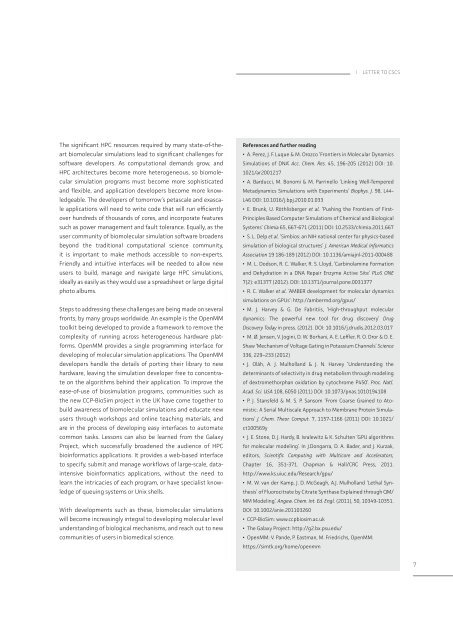Annual Report 2011 - CSCS
Annual Report 2011 - CSCS
Annual Report 2011 - CSCS
Create successful ePaper yourself
Turn your PDF publications into a flip-book with our unique Google optimized e-Paper software.
The significant HPC resources required by many state-of-theart<br />
biomolecular simulations lead to significant challenges for<br />
software developers. As computational demands grow, and<br />
HPC architectures become more heterogeneous, so biomolecular<br />
simulation programs must become more sophisticated<br />
and flexible, and application developers become more knowledgeable.<br />
The developers of tomorrow’s petascale and exascale<br />
applications will need to write code that will run efficiently<br />
over hundreds of thousands of cores, and incorporate features<br />
such as power management and fault tolerance. Equally, as the<br />
user community of biomolecular simulation software broadens<br />
beyond the traditional computational science community,<br />
it is important to make methods accessible to non-experts.<br />
Friendly and intuitive interfaces will be needed to allow new<br />
users to build, manage and navigate large HPC simulations,<br />
ideally as easily as they would use a spreadsheet or large digital<br />
photo albums.<br />
Steps to addressing these challenges are being made on several<br />
fronts, by many groups worldwide. An example is the OpenMM<br />
toolkit being developed to provide a framework to remove the<br />
complexity of running across heterogeneous hardware platforms.<br />
OpenMM provides a single programming interface for<br />
developing of molecular simulation applications. The OpenMM<br />
developers handle the details of porting their library to new<br />
hardware, leaving the simulation developer free to concentrate<br />
on the algorithms behind their application. To improve the<br />
ease-of-use of biosimulation programs, communities such as<br />
the new CCP-BioSim project in the UK have come together to<br />
build awareness of biomolecular simulations and educate new<br />
users through workshops and online teaching materials, and<br />
are in the process of developing easy interfaces to automate<br />
common tasks. Lessons can also be learned from the Galaxy<br />
Project, which successfully broadened the audience of HPC<br />
bioinformatics applications. It provides a web-based interface<br />
to specify, submit and manage workflows of large-scale, dataintensive<br />
bioinformatics applications, without the need to<br />
learn the intricacies of each program, or have specialist knowledge<br />
of queuing systems or Unix shells.<br />
With developments such as these, biomolecular simulations<br />
will become increasingly integral to developing molecular level<br />
understanding of biological mechanisms, and reach out to new<br />
communities of users in biomedical science.<br />
I LETTER TO <strong>CSCS</strong><br />
References and further reading<br />
• A. Perez, J. F. Luque & M. Orozco ‘Frontiers in Molecular Dynamics<br />
Simulations of DNA’ Acc. Chem. Res. 45, 196-205 (2012) DOI: 10.<br />
1021/ar2001217<br />
• A. Barducci, M. Bonomi & M. Parrinello ‘Linking Well-Tempered<br />
Metadynamics Simulations with Experiments’ Biophys. J. 98, L44-<br />
L46 DOI: 10.1016/j.bpj.2010.01.033<br />
• E. Brunk, U. Röthlisberger et al. ‘Pushing the Frontiers of First-<br />
Principles Based Computer Simulations of Chemical and Biological<br />
Systems’ Chimia 65, 667-671 (<strong>2011</strong>) DOI: 10.2533/chimia.<strong>2011</strong>.667<br />
• S. L. Delp et al. ‘Simbios: an NIH national center for physics-based<br />
simulation of biological structures’ J. American Medical Informatics<br />
Association 19 186-189 (2012) DOI: 10.1136/amiajnl-<strong>2011</strong>-000488<br />
• M. L. Dodson, R. C. Walker, R. S. Lloyd, ‘Carbinolamine Formation<br />
and Dehydration in a DNA Repair Enzyme Active Site’ PLoS ONE<br />
7(2): e31377 (2012). DOI: 10.1371/journal.pone.0031377<br />
• R. C. Walker et al. ‘AMBER development for molecular dynamics<br />
simulations on GPUs’: http://ambermd.org/gpus/<br />
• M. J. Harvey & G. De Fabritiis, ‘High-throughput molecular<br />
dynamics: The powerful new tool for drug discovery’ Drug<br />
Discovery Today in press. (2012). DOI: 10.1016/j.drudis.2012.03.017<br />
• M. Ø. Jensen, V. Jogini, D. W. Borhani, A. E. Leffler, R. O. Dror & D. E.<br />
Shaw ‘Mechanism of Voltage Gating in Potassium Channels’ Science<br />
336, 229–233 (2012)<br />
• J. Oláh, A. J. Mulholland & J. N. Harvey ‘Understanding the<br />
determinants of selectivity in drug metabolism through modeling<br />
of dextromethorphan oxidation by cytochrome P450’. Proc. Natl.<br />
Acad. Sci. USA 108, 6050 (<strong>2011</strong>) DOI: 10.1073/pnas.1010194108<br />
• P. J. Stansfeld & M. S. P. Sansom ‘From Coarse Grained to Atomistic:<br />
A Serial Multiscale Approach to Membrane Protein Simulations’<br />
J. Chem. Theor. Comput. 7, 1157-1166 (<strong>2011</strong>) DOI: 10.1021/<br />
ct100569y<br />
• J. E. Stone, D. J. Hardy, B. Isralewitz & K. Schulten ‘GPU algorithms<br />
for molecular modeling’. In J.Dongarra, D. A. Bader, and J. Kurzak,<br />
editors, Scientific Computing with Multicore and Accelerators,<br />
Chapter 16, 351-371. Chapman & Hall/CRC Press, <strong>2011</strong>.<br />
http://www.ks.uiuc.edu/Research/gpu/<br />
• M. W. van der Kamp, J. D. McGeagh, A.J. Mulholland ‘Lethal Synthesis’<br />
of Fluorocitrate by Citrate Synthase Explained through QM/<br />
MM Modeling’. Angew. Chem. Int. Ed. Engl. (<strong>2011</strong>), 50, 10349-10351.<br />
DOI: 10.1002/anie.<strong>2011</strong>03260<br />
• CCP-BioSim: www.ccpbiosim.ac.uk<br />
• The Galaxy Project: http://g2.bx.psu.edu/<br />
• OpenMM: V. Pande, P. Eastman, M. Friedrichs, OpenMM:<br />
https://simtk.org/home/openmm<br />
7


